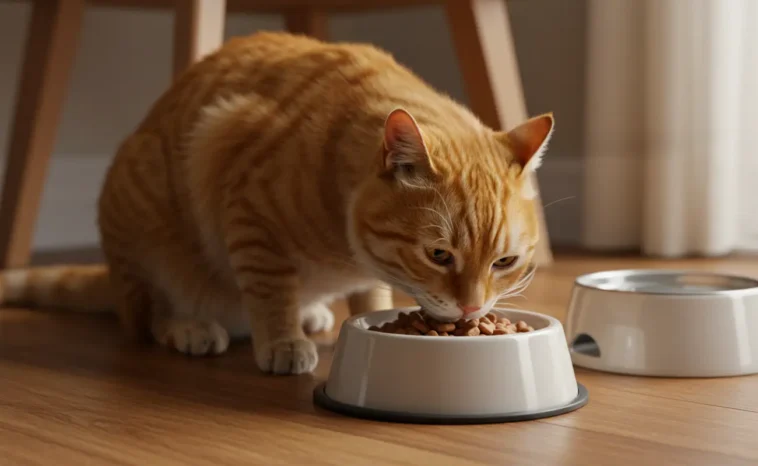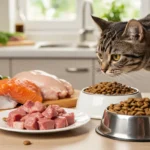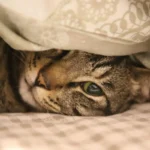The very first question many new cat owners ask is: how many cans of cat food a day should you feed your feline companion? Some cat parents refer to them as tins instead of cans, but the question remains the same—how do you figure out the right number to keep your cat healthy and happy?
If you’d like more information on selecting the right cat food in general—both wet and dry—check out our detailed guide: Good Quality Cat Food: How to Choose the Best Wet & Dry Options. By exploring that resource, you’ll gain additional insights into the best nutritional choices for your furry friend.
In this comprehensive article, we’ll break down the factors that influence how much wet food cats need, including whether you have a playful kitten or a sedentary senior cat. We’ll also touch on synonyms like “how many cans of cat food a day for kitten” and “how many tins of cat food a day”, which often appear in discussions about feeding routines. By the time you finish reading, you’ll know how to determine the optimal number of cans for your cat’s lifestyle, body condition, and health status.
Overview
Finding the right answer to how many cans of cat food a day requires considering multiple factors:
- Life Stage: Kittens, adults, and seniors all have unique nutritional requirements.
- Weight & Body Condition: A cat’s weight and general body shape are key indicators of whether you’re feeding too much or too little.
- Caloric Density of Food: Not all canned cat foods have the same calories per serving.
- Activity Level: Playful, active cats usually need more calories than sedentary cats.
- Health Conditions: Certain medical issues like kidney disease or diabetes might necessitate special feeding routines.
In the sections below, we’ll address these points in more depth. You’ll learn how to identify the signs of overfeeding and underfeeding, plus tips for making sure your cat gets the best possible diet.
Factors That Influence How Many Cans of Cat Food a Day Your Cat Needs
1. Life Stage and Age
Cats experience different caloric and nutritional needs throughout their lives:
- Kittens: When people ask, “how many cans of cat food a day for kitten?”, the answer is typically higher in both frequency and total calories than for adult cats. Kittens are in a critical growth phase requiring high-quality proteins, fats, and certain nutrients like DHA for brain development. You’ll likely feed them smaller, more frequent meals—sometimes three to four times per day—instead of the two-meals-a-day routine often used for adults.
- Adult Cats: Once cats mature (usually around one year), their daily caloric needs stabilize unless they’re pregnant, nursing, or highly active. It’s about maintenance at this stage: ensuring they neither gain nor lose weight unnecessarily.
- Senior Cats: Cats in their golden years (usually age 7+) might need fewer calories to avoid excess weight gain because they tend to be less active. However, seniors often benefit from higher-quality protein to maintain muscle mass and support organ function.
2. Weight and Body Condition
Veterinarians often use a Body Condition Score (BCS) scale that ranges from 1 (emaciated) to 9 (obese). A cat with a score of 4 or 5 typically has a healthy weight:
- Ribs should be felt but not visible (unless your cat’s breed naturally has a leaner look).
- Waist should be present behind the ribs when viewed from above, and the abdomen shouldn’t sag too much from the side.
If your cat is overweight, you may want to limit daily calories by reducing the total number of cans, adjusting dry food portions, or cutting back on treats. If underweight, increase daily feeding, or choose a more calorie-dense cat food.
3. Calorie Content per Can
Not all canned foods are created equal. One brand’s 3-ounce can may provide only 70 calories, while another can of the same size could provide 120 or more. Always check the label or the manufacturer’s website for “kcal per can.” Then, multiply by the number of cans you plan to serve each day to see if it aligns with your cat’s daily needs.
For instance, an average 10-pound adult cat typically needs around 200–250 calories per day (this is a guideline; individual needs can vary). If a can contains 80 calories, you might need about three cans to meet a 240-calorie requirement—assuming you’re not adding dry food or treats. If you’re supplementing with dry food, adjust accordingly.
4. Cat’s Activity Level
A cat that spends most of the day napping on a sunny windowsill will naturally have lower caloric needs than a cat that’s racing around the house chasing toys and scaling cat trees. If your cat is extremely playful, consider adding an extra half-can or more, especially if it appears to be losing weight or maintaining a leaner physique than desired.
5. Health Conditions
Certain ailments or life circumstances can drastically change a cat’s dietary needs:
- Diabetes: Cats with diabetes often need controlled carbohydrate intake. Your vet may recommend specific wet food formulas that help regulate blood sugar.
- Kidney Disease: Cats with compromised kidney function might need lower phosphorus content and moderate protein levels.
- Food Allergies/Sensitivities: You might need specialized limited-ingredient formulas to avoid triggering allergies, which can also affect how many cans per day they can safely consume without digestive upset.
Common Questions About how many cans of cat food a day
1. Should I Feed Exclusively Wet Food or Combine with Dry Food?
There’s no universal rule; it depends on your cat’s preferences, health, and your schedule:
- Exclusively Wet Food: Provides more moisture, which helps urinary and kidney health. However, it can be more expensive, and some cats refuse to eat cold leftovers if you store an opened can in the fridge.
- Combination Feeding: A popular option involves offering wet food at set meal times and leaving out a small portion of dry food for nibbling. This approach ensures your cat gets plenty of hydration from wet food while also enjoying the convenience of dry.
2. What if My Cat Doesn’t Finish the Food?
Some cats are notoriously finicky:
- Check the Freshness: Wet food left out for more than two to four hours may spoil, so your cat might not want to eat it later.
- Temperature Matters: Many cats dislike cold food straight from the fridge. Warm it slightly in the microwave (in a separate, microwave-safe dish) before serving.
- Palatability Enhancers: Sometimes adding a small amount of warm water or unsalted chicken broth makes the food more appealing.
3. How Do I Transition a Kitten from Kitten Food to Adult Food?
Kittens usually shift to adult formulas around 12 months of age, though larger breeds may continue kitten food until 18 months. Gradually mix adult food into the kitten food over 7–10 days to avoid digestive upset. Monitor portion sizes carefully, as adult formulas typically contain fewer calories than kitten-specific formulas.
4. Are There Breed-Specific Feeding Requirements?
Some breeds with higher muscle mass (e.g., Maine Coons) may need more calories, while certain slender breeds (e.g., Siamese) might benefit from more frequent, smaller meals. However, life stage, body condition, and activity level typically outweigh breed considerations.
5. Should I Free-Feed Wet Food?
Free-feeding wet food is less common than free-feeding dry kibble because wet food spoils faster and can attract bugs or grow bacteria. Most experts suggest feeding wet food in timed meals rather than leaving it out all day.
Tips for Feeding Your Cat the Right Amount
1. Stick to a Feeding Schedule
Establish specific times—morning, midday, evening—to feed wet food. Consistency helps you track your cat’s intake and spot potential problems like sudden appetite loss.
2. Measure Portions Carefully
Use measuring cups or a kitchen scale if you’re combining wet and dry food. This helps avoid accidental overfeeding, which can lead to obesity, or underfeeding, which could result in malnutrition.
3. Keep Fresh Water Available
Even though wet food contains moisture, cats still need daily access to clean water. Some cats prefer running water, so a pet fountain might encourage better hydration.
4. Adjust for Treats and Table Scraps
Treats and table scraps can add a significant amount of extra calories. Be mindful of how many you give. If you’re doling out treats regularly, reduce the amount of canned food accordingly.
5. Observe Behavioral Changes
A sudden shift—like a cat that was once eager to eat refusing multiple meals—could indicate illness or dental problems. Keep an eye on the litter box habits, too, as changes in stool consistency or frequency may suggest dietary issues.
Challenges and Solutions Related to How Many Cans of Cat Food a Day
Challenge 1: Overfeeding and Obesity
Problem: Cat obesity is increasingly common. Overweight felines are at higher risk for diabetes, joint issues, and cardiovascular problems.
Solution: Work with a veterinarian to set calorie goals. Spread out portions into smaller meals if your cat gulps down food quickly. Engage your cat in regular play sessions or short training exercises to burn off calories.
Challenge 2: Underfeeding and Nutritional Deficiencies
Problem: Some cats are picky eaters or may have health conditions causing reduced appetite. Chronic underfeeding can lead to weight loss and nutrient deficits.
Solution: Try different food flavors, textures, or brands. Warm the food slightly to enhance aroma. You can also ask your vet about appetite stimulants if your cat consistently refuses to eat.
Challenge 3: Multiple Cats, Different Needs
Problem: When you have multiple cats, one might be on a special diet while others are healthy or have different nutritional requirements.
Solution: Feed cats separately in different rooms or use microchip-activated feeders that open only for the intended cat. This ensures no cat can access food meant for another.
Challenge 4: Budget Constraints
Problem: Premium canned foods can be pricey, and cost becomes a significant factor if you have multiple cats or large breeds.
Solution: Look for bulk deals or sales. Consider mixing a budget-friendly wet food brand with a small portion of a high-quality dry kibble to balance cost and nutritional needs. Always read labels carefully to avoid unhealthy fillers.
Benefits of Proper Feeding Habits
When you determine the correct response to how many cans of cat food a day—and stick to that routine—you set up your cat for a healthier, happier life. Key benefits include:
- Weight Management: Proper portion control prevents obesity or underweight issues.
- Balanced Nutrition: Meeting daily protein, fat, vitamin, and mineral requirements fosters growth and maintenance for strong muscles, healthy organs, and a robust immune system.
- Fewer Health Complications: Cats on well-balanced diets are less prone to weight-related conditions like diabetes, arthritis, and heart disease.
- Higher Energy Levels: Adequate calorie intake fuels play and exploration, critical for mental stimulation and emotional well-being.
- Shinier Coat and Better Skin Health: Quality canned foods often have higher moisture and protein content, which translates to glossy fur and healthier skin.
Expert Opinions or Research on How Many Cans of Cat Food a Day
Veterinary nutrition experts often emphasize individualized feeding plans. Dr. Melissa Harper, a board-certified veterinary nutritionist, advises considering a cat’s specific energy requirements based on life stage, weight, and activity rather than relying on a one-size-fits-all approach. In her practice, she has seen that minor overfeeding—just one extra can a day—can lead to steady weight gain over several months.
Research published in the Journal of Feline Medicine and Surgery supports the importance of high-moisture diets. The study found that cats consuming wet food regularly had a lower risk of urinary tract infections and blockages. Still, the exact number of cans per day should align with the cat’s total caloric needs—which can vary from 180 to 300+ calories, depending on size and activity.
Frequently Asked Questions (FAQ)
1. How many cans of cat food a day for kitten if it seems constantly hungry?
Kittens typically have higher metabolic rates and may need to eat three to four meals per day. Start with 3–4 small cans (or the equivalent in wet kitten food) spread out. Monitor weight gain; if the kitten becomes chubby, dial back slightly. Always check calorie counts on the label and consult a vet if unsure.
2. Can I feed my kitten the same amount as an adult cat?
No, you shouldn’t. Kittens require more calories per pound of body weight than adults for their rapid growth. Kitten formulas are nutrient-dense, and adult formulas may not meet a kitten’s developmental needs.
3. Should I refrigerate leftover canned cat food?
Yes. Cover opened cans (with a lid or plastic wrap) and store them in the fridge. Before the next meal, let the food warm to room temperature or microwave briefly in a separate dish. Many cats dislike cold food and may refuse to eat it.
4. What if my cat isn’t drinking much water?
Wet food provides moisture, so some cats naturally drink less. Ensure fresh water is always available, and consider a water fountain if your cat seems uninterested in a regular bowl. If you notice signs of dehydration—lethargy, sunken eyes, or poor skin elasticity—contact your vet.
5. Is it okay to feed multiple types or brands of canned cat food?
Yes. Variety can prevent pickiness and provide a range of nutrients. Introduce new flavors gradually to avoid stomach upset. Rotating protein sources (chicken, fish, turkey, etc.) can also minimize the risk of food sensitivities over time.
Conclusion & Call-to-Action
Figuring out how many cans of cat food a day is right for your cat can seem daunting at first, but by considering factors like life stage, body condition, calorie content, and activity level, you can zero in on an ideal feeding plan. Kittens have special requirements and may need more frequent meals, while adult and senior cats often do well with set meal times and moderated portions.
Keep an eye on your cat’s weight and behavior to tweak the routine as needed. If you found this information helpful, share this article with other cat owners who might benefit from it. Also, feel free to leave a comment below with your own experiences or questions—you never know who else might be going through the same situation, and your insights could help them, too!






One Comment
Leave a ReplyOne Ping
Pingback:How Much Dry Food Should a Cat Eat a Day? Avoid Overfeeding & Obesity